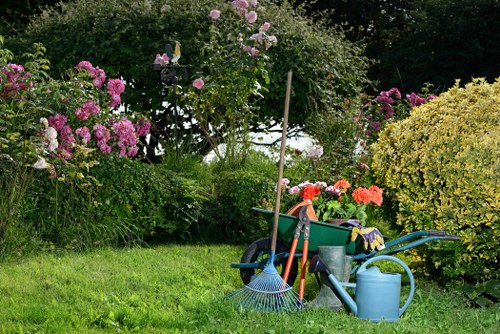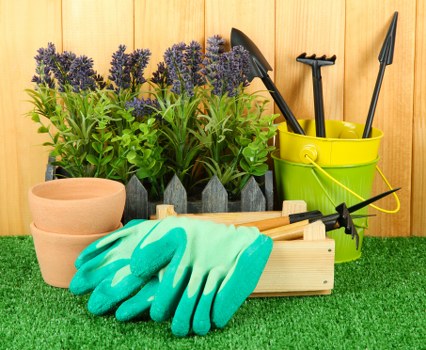Mastering the Art of Hedge Trimming: A Landscape Gardener’s Perspective

Hedge trimming is a fundamental aspect of landscape gardening, playing a crucial role in maintaining the aesthetics and health of garden spaces. Whether you're an amateur gardener or a professional landscaper, understanding the nuances of hedge trimming can significantly enhance the beauty and structure of your outdoor areas.
Proper hedge trimming not only ensures that your hedges are well-shaped and manicured but also promotes healthy growth. By regularly trimming hedges, you can prevent overgrowth, encourage denser foliage, and maintain the desired height and width of your plants.
In the realm of landscape gardening, hedge trimmers are indispensable tools. They make the task of cutting through dense foliage more manageable and precise, allowing gardeners to achieve clean and uniform cuts.

The Importance of Hedge Trimming in Landscape Gardening
Hedge trimming serves multiple purposes in landscape gardening. It enhances the visual appeal of your garden, provides privacy, and can even serve as a barrier against wind and noise.
Beyond aesthetics, regular trimming helps in maintaining the health of the plants. It removes dead or diseased branches, reduces the risk of pest infestations, and allows better light penetration and air circulation within the hedge.
Moreover, well-trimmed hedges can increase the value of your property by contributing to a well-maintained and attractive outdoor environment.

Choosing the Right Hedge Trimmer
Selecting the appropriate hedge trimmer is essential for effective and efficient trimming. There are various types available, each suited for different tasks and hedge sizes.
Manual Hedge Trimmers: These are ideal for small hedges and precise trimming. They offer greater control but require more physical effort.
- Best for small, delicate hedges
- Environmentally friendly with no noise pollution
- Suitable for detailed shaping

Electric vs. Gas-Powered Hedge Trimmers
When choosing between electric and gas-powered hedge trimmers, consider the size of the area you need to trim and your physical strength.
Electric Hedge Trimmers are lightweight, easier to maneuver, and quieter. They are perfect for residential gardens with moderate hedge sizes.
Gas-Powered Hedge Trimmers, on the other hand, are more powerful and suitable for larger properties with extensive hedges. They offer greater mobility without the limitations of a power cord.

Best Practices for Hedge Trimming
Adhering to best practices ensures that your hedge trimming is both effective and beneficial to the health of your plants.
- Timing: Trim your hedges during the growing season to encourage new growth. Avoid trimming during extreme weather conditions.
- Technique: Use smooth, even cuts to prevent damaging the plant. Avoid tearing or jagged edges.
- Maintenance: Keep your hedge trimmers clean and sharpened to ensure optimal performance.

Safety Tips for Using Hedge Trimmers
Safety should always be a priority when using hedge trimmers. Follow these tips to prevent accidents and injuries:
- Wear appropriate protective gear, including gloves and safety glasses.
- Ensure that the hedge trimmer is in good working condition before use.
- Be aware of your surroundings to avoid injuring yourself or damaging nearby plants and structures.

Maintaining Your Hedge Trimmer
Regular maintenance of your hedge trimmer extends its lifespan and ensures it performs efficiently. Here’s how you can maintain your tool:
Cleaning: After each use, clean the blades of any plant residue to prevent rust and maintain cutting efficiency.
Sharpening: Dull blades make trimming harder and can damage plants. Sharpen the blades regularly for clean cuts.
Storage: Store your hedge trimmer in a dry place to protect it from moisture and environmental damage.

Enhancing Garden Health through Proper Trimming
Proper hedge trimming promotes the overall health of your garden by:
- Improving air circulation, reducing the risk of fungal diseases
- Encouraging even growth, leading to a fuller and more vibrant hedge
- Removing dead or unhealthy branches, preventing the spread of pests

Innovative Techniques in Hedge Trimming
Modern landscape gardeners employ various innovative techniques to achieve superior hedge trimming results:
Topiary: This art involves shaping hedges into intricate forms and designs, adding an artistic touch to the garden.
Feathering: A technique where the hedge is trimmed in such a way that the top is slightly narrower than the base, allowing light to penetrate and promoting healthier growth.
Scalloping: Trimming the hedge in a wavy pattern instead of straight lines, giving it a more natural and dynamic appearance.

Environmental Benefits of Regular Hedge Trimming
Beyond aesthetics and plant health, hedge trimming offers environmental benefits:
- Carbon Sequestration: Healthy hedges capture and store carbon dioxide, helping to mitigate climate change.
- Biodiversity: Well-maintained hedges provide habitats for various wildlife, enhancing garden biodiversity.
- Air Quality: Hedges improve air quality by absorbing pollutants and producing oxygen.
Choosing the Right Plants for Your Hedges
The success of your hedge trimming efforts largely depends on the types of plants you choose for your hedges. Selecting plants that are well-suited to your climate and soil conditions will make maintenance easier and ensure healthier growth.
Consider using evergreen plants for year-round privacy and color, or deciduous plants if you prefer seasonal changes in your garden's appearance.
Popular hedge plants include:
- Boxwood: Known for its dense foliage and versatility in shaping
- Privet: Fast-growing and excellent for creating thick barriers
- Yew: Long-lived with rich green needles, ideal for topiary
Seasonal Hedge Trimming Tips
Different seasons require varying trimming approaches to ensure optimal growth and health of hedges:
- Spring: Perform light trimming to encourage new growth after winter dormancy.
- Summer: Focus on shaping and controlling the size of the hedge to prevent overgrowth.
- Autumn: Remove any dead or damaged branches and prepare the hedge for winter.
- Winter: Minimal trimming is required; perform necessary maintenance to protect the hedge from harsh weather.
Common Mistakes to Avoid in Hedge Trimming
Avoiding common mistakes can make your hedge trimming more effective and preserve the health of your plants:
- Over-Trimming: Cutting too much at once can stress the plants and inhibit growth.
- Incorrect Timing: Trimming at the wrong time of year can disrupt the plant's natural growth cycle.
- Using Dull Tools: Dull trimmers can cause ragged cuts, making plants more susceptible to disease.
Professional vs. DIY Hedge Trimming
Deciding whether to hire professional landscape gardeners or undertake hedge trimming yourself depends on several factors:
Professional Services: Offer expertise, save time, and ensure high-quality results, especially for large or complex hedges.
DIY Trimming: Cost-effective and offers personal satisfaction, suitable for smaller hedges and those comfortable with garden maintenance.
Regardless of the choice, understanding the basics of hedge trimming can enhance the effectiveness of either approach.
Investing in Quality Hedge Trimmers
Quality hedge trimmers are a worthwhile investment for any landscape gardener. They provide precision, durability, and efficiency, making the trimming process smoother and more enjoyable.
When selecting a hedge trimmer, consider factors like blade quality, weight, ergonomics, and power source to find the best fit for your gardening needs.
Regularly maintaining your hedge trimmers ensures they remain in top condition, providing reliable performance for years to come.
Ready to transform your garden with professional hedge trimming services? Contact us today and let our skilled landscape gardeners help you achieve the lush, well-maintained hedges you've always desired.